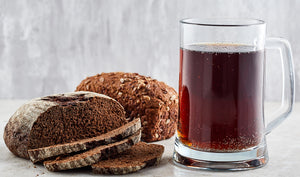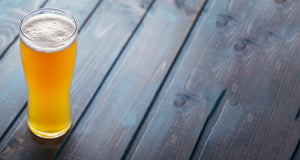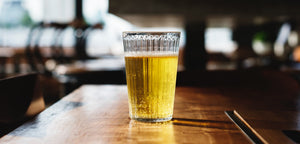Most beginner homebrewers, and even many seasoned homebrewers, bottle their beer. While it's not the most efficient way to store and carbonate your brew, there are some advantages. There is also room for problems to arise, especially if you don't follow proper cleaning and sanitizing procedures.
This guide will show you how to properly clean, sanitize and fell your beer bottles to make sure you get the best beer possible.
Advantages & Disadvantages
If you're a homebrewer who likes to share their beer with friends, bottling is probably the best option for you. While you can fill bottles and growlers from a keg, grabbing a few bottles to take to game night or a party is much easier.
Bottling is also a great way to age special brews. You may not want to keg a Russian Imperial Stout that needs to age. Bottling and cellaring these types of beer is the best option.
Homebrewers will tell you the three biggest disadvantages to bottling is the cleaning and sanitizing, storage, and the wait time for carbonation. While these take time, space and even more time, if you're not ready to invest in equipment to keg your beer, it's generally easy to stick with bottling.
Types of Bottles
When bottling your homebrew, you have a choice of several types of beer bottles. While the type of bottle you use is generally a personal preference, there are some advantages and disadvantages of each.
- Standard Beer Bottles: Come in a variety of sizes. Require non-reusable crown caps and a capper.
- Flip Top Bottles: Available in different sizes. Cap is attached to the bottle but they need to be "installed" when you receive the bottles. Washers sometimes need to be replaced.
- PET Plastic Bottles: Lightweight and available in different sizes. Come with re-useable screw-on caps, but you need to keep an eye on the state of the cap thread and seal. The bottles and replacement caps are inexpensive, but some brewers don't like storing their homebrew in plastic.
Cleaning & Sanitizing
Cleaning and sanitizing is the most crucial step to the bottling process. No matter how good your brew is, if your bottles aren't cleaned thoroughly and sanitized you're at a higher risk for all that hard work to go down the drain.
The easiest way to make sure your bottles are in the proper condition to come in contact with your beer is to rinse out bottles after you finish a beer (to avoid sediment from caking on or going moldy), and sanitize right before bottling.
Cleaning

If you have bottles with visible sediment in them, use a good cleaner and a bottle brush to give them a good scrub. You may also have to let them soak with cleaner to loosen the build up.
Make sure you follow the instructions for your cleaner, for both proper dilution and rinsing (cleaners like Pink Chlorinated require multiple rinses).
Sanitizing

Once your bottles are clean of any residue or buildup, you need to sanitize them. We recommend StarSan for bottle sanitizing because it's a no-rinse sanitizer and won't affect your beer at all.
The easiest way to sanitize bottles at home is to set up a bottle tree and a bottle sanitizing dish. Mix your StarSan with water according to the directions, and put some of the solution into the dish. Prime the dish until the solution begins to come out the top into the bottles. Give each bottle a few pumps on the dish, then place them on the bottle tree to drip dry. It's good to spray your bottle tree with some StarSan since your bottles will come in contact with it.

Bottling & Storage
Filling
After you've added your priming sugar to your beer, it's time to bottle. Bottling is an easy process, but can be time consuming depending on how large your batch is, and how small your bottles are.
Attach a bottle filler to your siphon hose and fill each bottle 1/2" - 1" from the top. This space allows for carbonation. Too little space and your beer could be over-carbonated, and too much space in your bottle and your beer may not carbonate properly.

The easiest way to make sure you get even space in each bottle is to use a spring loaded bottle filler and fill to the top. When you remove the bottle filler, the spring will stop the flow of liquid and the space the filler took in the bottle will leave you with enough space.
Capping

Once your bottles are filled, it's time to cap them. Most beginner brewers use a hand capper. These cappers have a lever for each hand and a magnet to hold the cap and are easy to use.
Put a crown cap on the magnet, place it over the bottle in the proper position and press down on both levers. This will crimp your cap over the bottle and create a seal.
Storage
When all your bottles are capped, store them in a cool place, away from light, to allow them to carbonate. This process usually takes around two weeks. Feel free to crack one open early to get a feel for how your beer tastes and how carbonation is going. Keep in mind that if you open one early, while carbonation is still happening, the beer may taste sweeter than you expect because of the bottling sugar.



